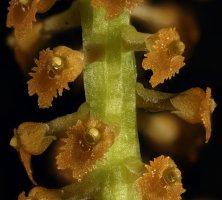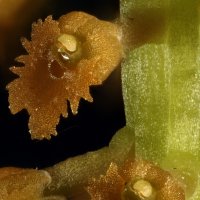I've been playing around with the new 5D sr to see how it behaves in the macro area. I shot some small orchid flowers, total height 2 mm each, with MPE 65 mm at 1:1, 2:1, 3:1, 4:1, 5:1 and with TC 1.4xIII at 7:1. Each set at f/2.8 and f/4: all open for maximum resolution (here meant as the traditional separating two points in object), and 1 stop down for possible aberration correction and overall improved IQ. Between 60 and 175 frames were shot per set-up. Flashed manually with MT-24Ex at around 1/64-1/32 power, so very short exposure times. Flash heads mounted off lens to ensure consistent illumination angles. Stacking done on Cogynsis Stackshot with steps down to 19 µm. Stacking steps calculated as 70% of DoF with c = 0.03 mm in 8 x 10" print.
Processing on 6 core MacPro soup can with 32 GB RAM. Mac OS Yosemite does not reliably display thumbnails of CR2 file icons in finder. No idea why. RAW files were run through DxO (latest download). In previous DxO you could double click one image in directory, and all images in that directory would load, but this leads to many errors and hang-ups with 5Ds files and latest DxO version. Drag-drop images into the DxO interface is 100% reliable. It takes time to process >100 files, but can be done on MacPro. Activity monitor had all processors going full throttle for several minutes, with quite a bit of heat coming out of the vent. I would not advise doing that on a laptop.
In previous tests with 5D2 files, RAW file processing was quicker in DxO than in PS CS5.5 extended with batch processing.
Stacking in Zerene with 300 MB 16 bit .tif files was flawless. For me the P-max algorithm works best.
With the huge file sizes and small pixels, the question arises at what magnification is nothing gained anymore in terms of better information? This point is reached at 4:1, where f/2.8 becomes effective f-stop f/14. This is a bit higher than what diffraction limited calculations arrive at (f/6.7–11, in most discussions). f/4 resulted in slightly softer images.
Comparing 5D2 images of same plant to the 5D sr, 5D2 still gains information at 5:1 (did not try 7:1), but still on fewer pixels. With 5D sr you can take a larger field of view at 4:1, print larger, and crop heavier, and get same information, mostly as expected.
Attached is a 4:1 f/2.8 image, 111 image stack: full image height down sampled to 1000 pixels, cropped some of the black side areas out. Again, flowers are 2 mm high, the bubbles are individual cells, about 20–40 µm in diameter, resolution limit seems to be at around 10 µm, which is about right for anything short of epi objective lenses on compound microscope. On dedicated stereomicroscope you can get down to around 4–6 µm (1.22 lamda/NA).
Enjoy!
Processing on 6 core MacPro soup can with 32 GB RAM. Mac OS Yosemite does not reliably display thumbnails of CR2 file icons in finder. No idea why. RAW files were run through DxO (latest download). In previous DxO you could double click one image in directory, and all images in that directory would load, but this leads to many errors and hang-ups with 5Ds files and latest DxO version. Drag-drop images into the DxO interface is 100% reliable. It takes time to process >100 files, but can be done on MacPro. Activity monitor had all processors going full throttle for several minutes, with quite a bit of heat coming out of the vent. I would not advise doing that on a laptop.
In previous tests with 5D2 files, RAW file processing was quicker in DxO than in PS CS5.5 extended with batch processing.
Stacking in Zerene with 300 MB 16 bit .tif files was flawless. For me the P-max algorithm works best.
With the huge file sizes and small pixels, the question arises at what magnification is nothing gained anymore in terms of better information? This point is reached at 4:1, where f/2.8 becomes effective f-stop f/14. This is a bit higher than what diffraction limited calculations arrive at (f/6.7–11, in most discussions). f/4 resulted in slightly softer images.
Comparing 5D2 images of same plant to the 5D sr, 5D2 still gains information at 5:1 (did not try 7:1), but still on fewer pixels. With 5D sr you can take a larger field of view at 4:1, print larger, and crop heavier, and get same information, mostly as expected.
Attached is a 4:1 f/2.8 image, 111 image stack: full image height down sampled to 1000 pixels, cropped some of the black side areas out. Again, flowers are 2 mm high, the bubbles are individual cells, about 20–40 µm in diameter, resolution limit seems to be at around 10 µm, which is about right for anything short of epi objective lenses on compound microscope. On dedicated stereomicroscope you can get down to around 4–6 µm (1.22 lamda/NA).
Enjoy!


